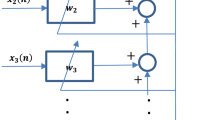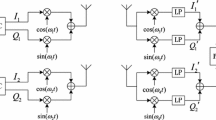Abstract
Independent Component Analysis (ICA) is one of the fastest growing fields in the area of neural networks and signal processing. Blind Source Separation (BSS) is one of the applications of ICA. In this paper, ICA has been used for separating unknown source signals. BSS is used to extract independent signal components from their observed linear mixtures at an array of sensors. Various statistical techniques based on information theoretic and algebraic approaches exist for performing ICA. In this paper, we have used an objective function based on independence criterion of the signals. Optimisation of this objective function yields a neural algorithm along with a non-linear function for signal separation. Performance of the algorithm for artificially generated signals as well as audio signals has been evaluated.


Similar content being viewed by others
References
Comon P (1994) Independent component analysis, a new concept? Signal Process 36:287–314
Amari SI, Cichoki A, Yang H (1996) A new learning algorithm for blind signal separation. Advances in Neural Information Processing Systems, Vol 8, pp 757–763, Denver, CO
Bell AJ, Sejnowski TJ (1995) An information–maximization approach to blind separation and blind deconvolution. Neural Computation 7:1004–1034
Lee T-W, Girlomi M, Sejnowski TJ (1999) Independent component analysis using an extended infomax algorithm for mixed sub-Gaussian and super-Gaussian sources. Neural Computation 11(2):409–433
Singh Y, Rai CS (2002) Blind source separation: an unified approach. Neurocomputing 49(1–4):435–438
Singh Y, Rai CS (2001) A non-linear function for gradient based BSS. Proc IJCNN 2001, pp 936–939, Washington DC
Cardoso JF (1998) Super-symmetric decomposition of the fourth order cumulant tensor. Proc ICASSP, pp 3109–3112
Cardoso JF, Laheld BH (1996) Equivariant adaptive source separation. IEEE Trans Signal Process 44(12):3017–3030
Cardoso JF (1998) Blind signal separation: statistical principal. Proc IEEE 9(10):2009–2025
Haverinen A, Oja E (1997) A fast fixed point algorithm for independent component analysis. Neural Computation 9:1483–1492
Karhunan J, Oja E, Wang L, Vigario R, Joutsensalo J (1997) A class of neural networks for independent component analysis. IEEE Trans Neural Networks 8:487–504
Cichoki A, Unbehauen U, Rummert E (1994) Robust learning algorithm for blind separation of signals. Electr Lett 30(17):1386–1387
De.Lathauwer L, De.Moor B, Vandewalle J (1995) Fetal electro-cardiogram extraction by source sub-space separation. Proc HOS’95, Spain, pp 134–138
Makeig S, Bell A, Jung TP, Sejnowskim TJ (1995) Independent component analysis of electroencephalographic data. Advances in Neural Information Processing Systems, vol 8, MIT Press
Ziegaus C, Lang EW (1999) Independent component extraction of natural images based on fourth-order cumulants. ICA99, Aussois, France, pp 115–120
Bell AJ, Sejnowski TJ (1996) Edges are the ‘independent components’ of natural scenes. Advances in Neural Information Processing Systems, vol 9, MIT Press
Chaumette E, Common P, Muller D (1993) “CA-based technique for radiating sources estimation: application to airport survellience. IEE Proc-F 140(6):395–402
Swindlehurst A, Goris M, Otterson B (1997) Some experiments with array data collected in actual urban and sub-urban environment. IEEE Workshop on Signal Processing Advances in Wireless Communication, pp 301–304
Anand K, Mathew G, Reddy G (1995) Blind separation of multiple co-channel BPSK signals arriving at an antenna array. IEEE Signal Process Lett 2(9):176–178
Thirion N, Mars J, Boelle JL (1996) Separation of seismic signals: a new concept based on blind algorithm. Signal Processing VIII, Theories and Applications, Triest, Italy, pp 85–88
Papoulis A (1991) Probability, random variables, and stochastic processes. McGraw-Hill
Stuart A, Ord JK (1991) Kendal’s advanced theory of stistics. Edword Arnold
Author information
Authors and Affiliations
Corresponding author
Rights and permissions
About this article
Cite this article
Singh, Y., Rai, C.S. A simplified approach to independent component analysis. Neural Comput & Applic 12, 173–177 (2003). https://doi.org/10.1007/s00521-003-0379-7
Received:
Accepted:
Published:
Issue Date:
DOI: https://doi.org/10.1007/s00521-003-0379-7




